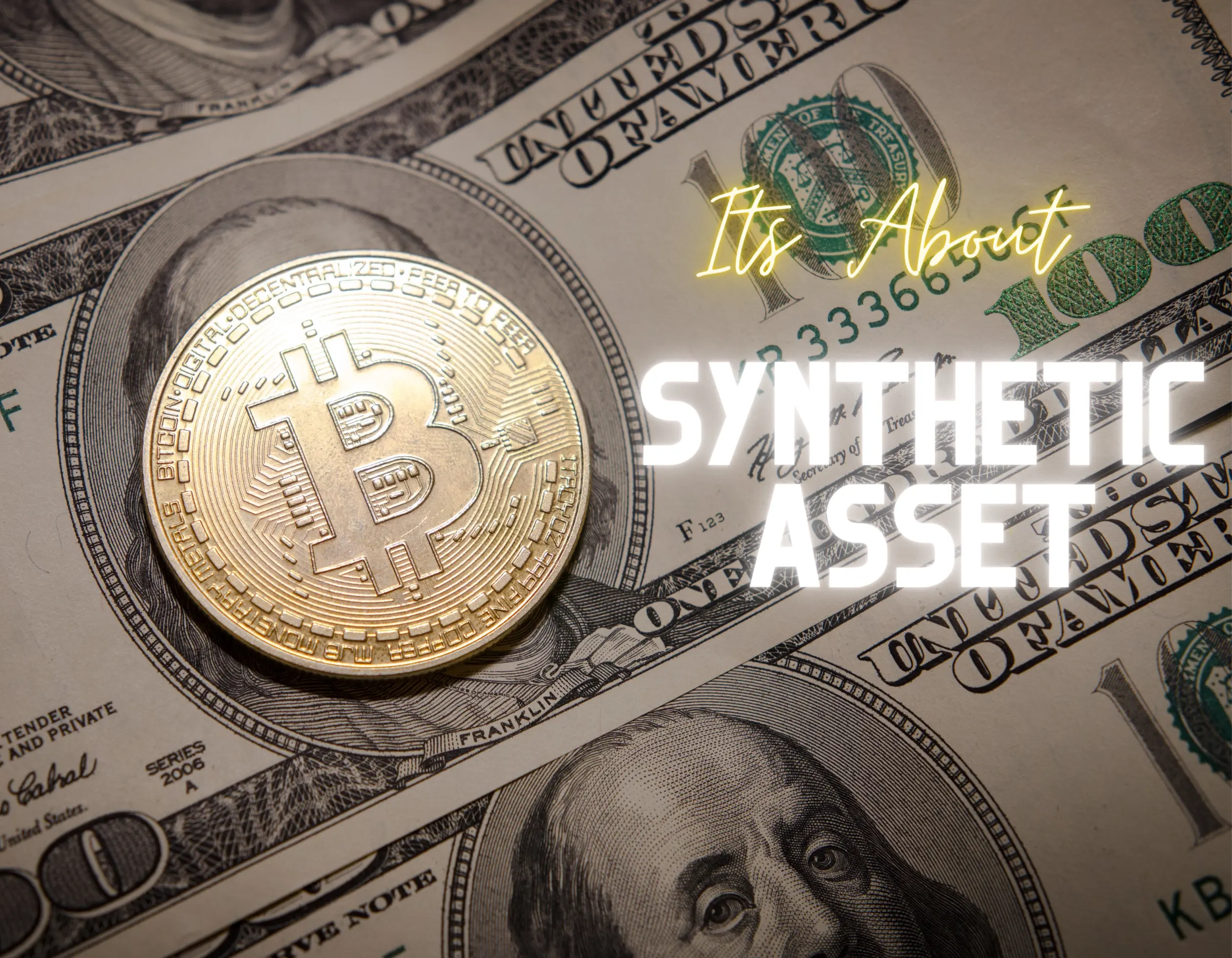What Are Synthetic Assets?
Synthetic assets are digital copies of real-world assets. They’re created using financial contracts and derivatives, making them easy to trade and providing access to various assets. These assets combine different characteristics of the original assets, making investing simpler and more accessible, especially for assets that are difficult to trade directly. They’re issued on blockchain platforms, ensuring transparency and security in transactions.
The rise of synthetic assets is changing the way investors interact with assets, providing greater flexibility and liquidity. Yet, they bring risks like counterparty credit risk and tracking errors. Nonetheless, synthetic assets are revolutionizing capital markets by expanding investment options. This opens doors for investors to diversify portfolios and enhance returns.

Table of Contents
Differentiating Traditional and Crypto Synthetic Assets
Traditional assets are real things like money or stuff you can touch, and people trade them on big money markets. But crypto synthetic assets are digital things made using fancy computer technology called blockchain. They copy the value and stuff from traditional assets, but they only exist online.
The big difference between regular and crypto synthetic assets is that regular ones are real, like having paper certificates or holding cash, while crypto synthetic only live on the internet.
Even though crypto synthetics have cool things like being easy to get, lots of money available, and you can change how they work, they also have some risks. These could be stuff like problems with the computer programs that run them, not knowing how the rules will change, or prices jumping up and down suddenly because they’re all digital.
But some people still like crypto synthetics because they’re different and let you do new stuff with your money.
Different Types of Digital Synthetic Assets
Crypto synthetic assets come in different types, like stablecoins that act like regular money, tokenized stuff like gold or stocks, tokens that change value depending on other stuff, and assets that give you rewards for holding them. Let’s break it down:
- Stable coins: These are digital coins that stay the same value as real money, like the US dollar or euro, to help with buying stuff and keeping your money safe in the crypto world. For example, there’s a token called sUSD that’s like having dollars in your crypto wallet.
- Tokenized Commodities and Stocks: These are like digital versions of real things, such as gold, oil, or company shares. They let you own a part of these things without actually having them physically. For instance, there’s a token called soil that copies the price of oil, so you can invest in it without dealing with actual oil barrels.
- Leverage and Inverse Tokens: These are special tokens that make your gains or losses bigger based on how another asset moves. If the price of something goes up, these tokens go up even more, and if it goes down, they might go down more too. For example, a token like BTC3L aims to make three times the profit of Bitcoin’s price changes.
- Yield-Bearing Assets: These are tokens that give you rewards just for holding them. You might get extra tokens or money for keeping them in your wallet, which can be a way to earn passive income. An example is cDAI, where you can earn interest just for holding a certain type of cryptocurrency.
So, these different types of crypto synthetic assets offer various ways to invest and earn in the digital world.
What is the functioning mechanism of synthetic tokens?
Synthetic tokens are digital assets traded on decentralized finance (DeFi) platforms, which leverage blockchain technology to facilitate financial transactions without intermediaries. These platforms enable users to engage in various financial activities, such as lending, borrowing, and trading, directly peer-to-peer.
Creating synthetic tokens typically involves two main steps: Collateralization and Minting. In the Collateralization process, users deposit cryptocurrency or tokens as collateral to support the creation of the synthetic token. This collateral acts as a security measure, ensuring that the synthetic token maintains its value.
During the Minting phase, a smart contract executes the creation of the synthetic token and assigns it a value based on the assets it represents. This value is typically tied to the price of the underlying asset, providing investors with exposure to the asset’s price movements without directly owning it.
Once minted, the value of a synthetic token fluctuates in response to changes in demand for its underlying asset. If demand for the asset increases, the value of the synthetic token rises accordingly, and vice versa.
Synthetic tokens offer users the opportunity to access a diverse range of assets without the need to own them directly. This opens up new avenues for participation in DeFi platforms, allowing investors to diversify their portfolios and manage risk more effectively.
The Collateralization mechanism plays a crucial role in maintaining the stability and reliability of synthetic tokens by ensuring that there are sufficient assets backing their value. This instills confidence in market participants and contributes to the overall efficiency and effectiveness of DeFi ecosystems.
Applications of Digital Synthetic Assets
Crypto synthetic assets serve various purposes and cater to different users in the crypto world:
- Trading and Investment: They provide opportunities for traders to engage in leveraged trading, which means they can make bigger bets on price movements, potentially leading to higher profits (or losses). These assets cover a wide range of crypto investments like stocks and commodities, making it easy for investors to diversify their portfolios.
- Yield Farming and Providing Liquidity: People who hold crypto synthetic assets can earn rewards by participating in yield farming, where they contribute to liquidity pools in DeFi platforms. This helps boost liquidity, which is important for smooth trading, lending, and borrowing in the DeFi space.
- Risk Management and Hedging: Synthetic assets offer tools for managing risk and hedging against market downturns. For example, inverse synthetic assets can act as protection against losses in other investments. Also, synthetic stablecoins offer a decentralized way to keep assets stable amidst the volatility of the market.
Obstacles and Dangers
Despite their innovative potential, synthetic assets come with various challenges and risks:
- Smart Contract Risks: Complex smart contracts used to create synthetic assets can have vulnerabilities that hackers may exploit, leading to significant financial losses.
- Liquidity Challenges: Some synthetic assets may have limited liquidity compared to real-world assets. This can result in difficulties such as price manipulation and trading slippage.
- Regulatory Uncertainty: The regulatory environment for synthetic assets is still unclear. Governments are figuring out how to classify and regulate these assets, leading to ongoing legal disputes and changes in regulations.
- Oracle-Related Issues: Synthetic assets rely on oracles to access real-world data. However, these systems can be vulnerable to manipulation or compromise, potentially impacting the accuracy and reliability of synthetic assets.
Overall, while synthetic assets offer innovative solutions, users must be aware of and carefully consider these risks before investing or trading in them.
Closing Statement
Synthetic assets represent an exciting frontier in both finance and the crypto world. These assets bring several advantages, like being easier to access, more flexible, and offering a wider range of options. However, they also carry risks, like possible problems with having enough cash on hand or concerns about the people or companies involved.
Despite these challenges, synthetic assets have a ton of potential uses. They can be used to make real things digital, or even to create brand-new ways of doing finance stuff. As the industry keeps growing and changing, it’s clear that synthetic assets are shaking things up and leading the charge toward a financial future that’s more open, easier to get into, and full of cool new ideas.
Share this content:

